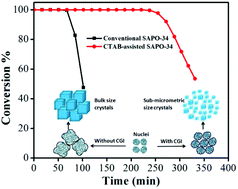CTAB-assisted size controlled synthesis of SAPO-34 and its contribution toward MTO performance†
Abstract
SAPO-34 shows higher light olefin selectivity in the reaction of methanol to olefin (MTO), but its small pore system implies diffusion limitations to bigger molecular products and results in coking too. To inhibit these limitations, sub-micrometric sized SAPO-34 crystallites were successfully synthesized by a facile surfactant-assisted hydrothermal synthesis route, in which cetyltrimethylammonium bromide (CTAB) was used as a crystal growth inhibitor (CGI). It was found that the crystal size changes in the V shape with the increase in the amount of CTAB. The sub-micrometric sized sample (SP-0.02CTAB) was obtained when the molar ratio of CTAB to Al2O3 was 0.02 in a precursor gel. The SP-0.02CTAB catalyst presents excellent performance for the MTO reaction with 97.8% C2–C4 selectivity and 3 times longer lifetime than the conventional SAPO-34 sample (SP-Conv), which is attributed to its much higher surface area and enhanced acidity derived from the formation of the sub-micrometric sized crystallites. Further study about the appropriate time of CTAB addition demonstrates that CTAB can play its role as a crystal growth inhibitor effectively, only when it is added at the very initial stage of the crystallization process.



 Please wait while we load your content...
Please wait while we load your content...